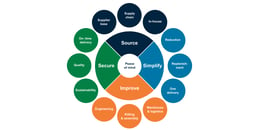- Insights
- The Solutionists Hub
- How to Source C-Parts: Tips for Purchasers
How to Source C-Parts: Tips for Purchasers

During my time as a purchaser, I learned that effective sourcing is essential. From personal experience, I know that you're responsible for ensuring that your company's manufacturing has the parts it needs at the right quality, price, and time. Failing to source the required parts can mean extended periods of downtime in the most severe cases, and if that happens, the blame usually falls on you.
Sourcing is essential, but it's not always easy – there's a vast number of suppliers across the world who can supply you with the parts you need, and it can be challenging to choose. Additionally, the fact that many C-parts manufacturers are located on the other side of the world can make the practical task of getting the right parts very tricky. On top of this, factors like supply chain disruptions, high MOQs, and long lead times can make it hard to get your parts when you need them.
When I worked as a purchaser, I know I would have benefited from easier sourcing. For me, these are the most important tips for finding a source of C-parts that your company can rely on:
- Make availability the top priority
- Focus on fast delivery
- Look for flexibility
In this article, I'll expand a bit more on these factors. If you find a supplier that can provide all of them, the number of sourcing issues you deal with daily will quickly go down.
High levels of C-parts availability
Most C-parts purchasers I speak to say availability is their top priority. Factors like price and quality are important, of course – but at the end of the day, the factory needs the right parts to keep the production line moving.
For this reason, it's essential you source parts from a supplier who can give you a good level of availability. You should look for a supplier with a broad, global network of sub-suppliers, because they can quickly adjust if one supplier can't deliver the needed goods in the right quantity, at the right time, or at the right price.
It's even better if the supplier you partner with also has in-house production of special parts, as well as partnerships with a network of external suppliers – this decreases their reliance on external partners and increases the chances they'll have all the parts you need.

Fast, efficient deliveries
Unfortunately, lots of purchasers in your position don't always have a comprehensive overview of current stock levels in the manufacturing operation. As a result, they're not always aware of shortages until stock levels become dangerously low. Additionally, if more C-parts are used than expected, or if they're lost or misplaced, a shortage can occur well before the purchaser's forecast.
In these situations, fast delivery is vital. To fix the problem, you need to get hold of the required parts as soon as possible – but if your supplier's delivery times are too long, you're in trouble. An ideal supplier should be able to get C-parts to you even at short notice. It helps if their distribution centers are relatively close to your manufacturing facilities – if you need to wait for a parts shipment from China, your manufacturing operation could suffer.
Flexibility and responsiveness
Your parts procurement work instantly becomes more manageable if your supplier is flexible and responsive. Flexibility is essential if your C-parts needs are complex, if you need your parts by a specific date, or if a particularly high or low quantity is needed. This is often a challenge if you work with many suppliers, making small orders from each one. Often, they're not willing to be especially flexible for a company that is, for them, a relatively small customer.
Similarly, a supplier you can safely source your parts from should actually respond to you in good time. I deal with plenty of purchasers who find it very difficult to get in touch with their suppliers when they need them – something that can be disastrous if you're on a tight schedule or if the quality of the supplied C-parts isn't good enough.

If your existing C-parts suppliers don't have the qualities I've described above, you're not alone – these are common problems that almost every purchaser and sourcing manager has to deal with at some point. If you'd like to learn more about how to solve these problems, make sure to take a look at The Purchaser's Guide to C-Parts. It explains how vital an efficient flow of C-Parts is to your operation and gives some ideas on how you can make your procurement and purchasing easier.
Learn more about supplier consolidation
We also have a Purchaser's Guide to Supplier Consolidation, available to download as a presentation below. It explains the advantages and practical application of supplier consolidation, which could be an excellent solution if you're currently struggling with unsatisfactory suppliers.
Download the free guide

Get the guide to supplier consolidation
Get new knowledge every week!
Related
-
By Jonas CaseliusHow Does the C-Parts Supplier Consolidation Process Work in Practice?
-
By Maria GötessonCommon C-Parts Purchasing KPIs, and How to Improve Them
-
By Oskar SvenssonVendor Managed Inventory: The Benefits of VMI for C-Parts Purchasers
-
By Jacob BergströmWhat is the Total Cost of Ownership in C-Parts Purchasing?
-
By Tuomo TiainenMy Tips for How to Succeed as a C-Parts Purchaser
-
By Carina LööfSustainable Purchasing: Guidance for C-Parts Purchasers
-
By Slawomir BieszkMOQ: How to Deal With High Minimum Order Quantity for C-Parts








